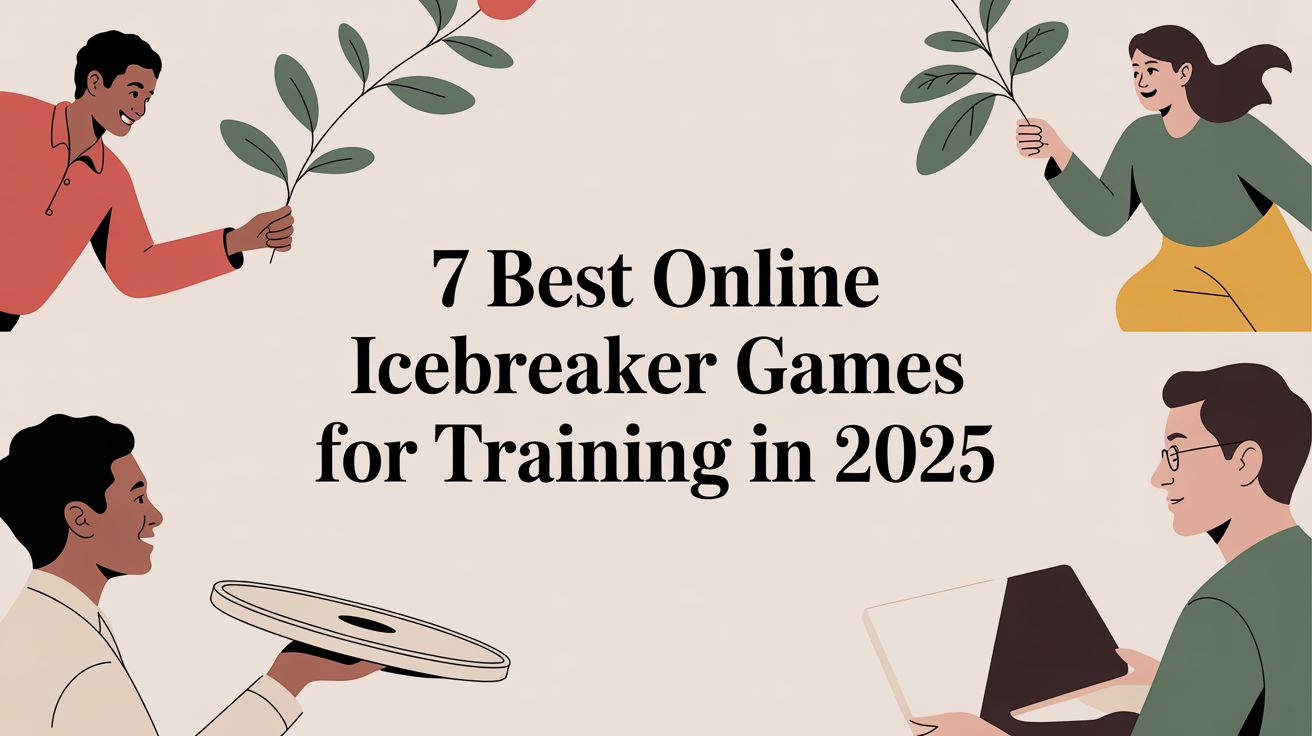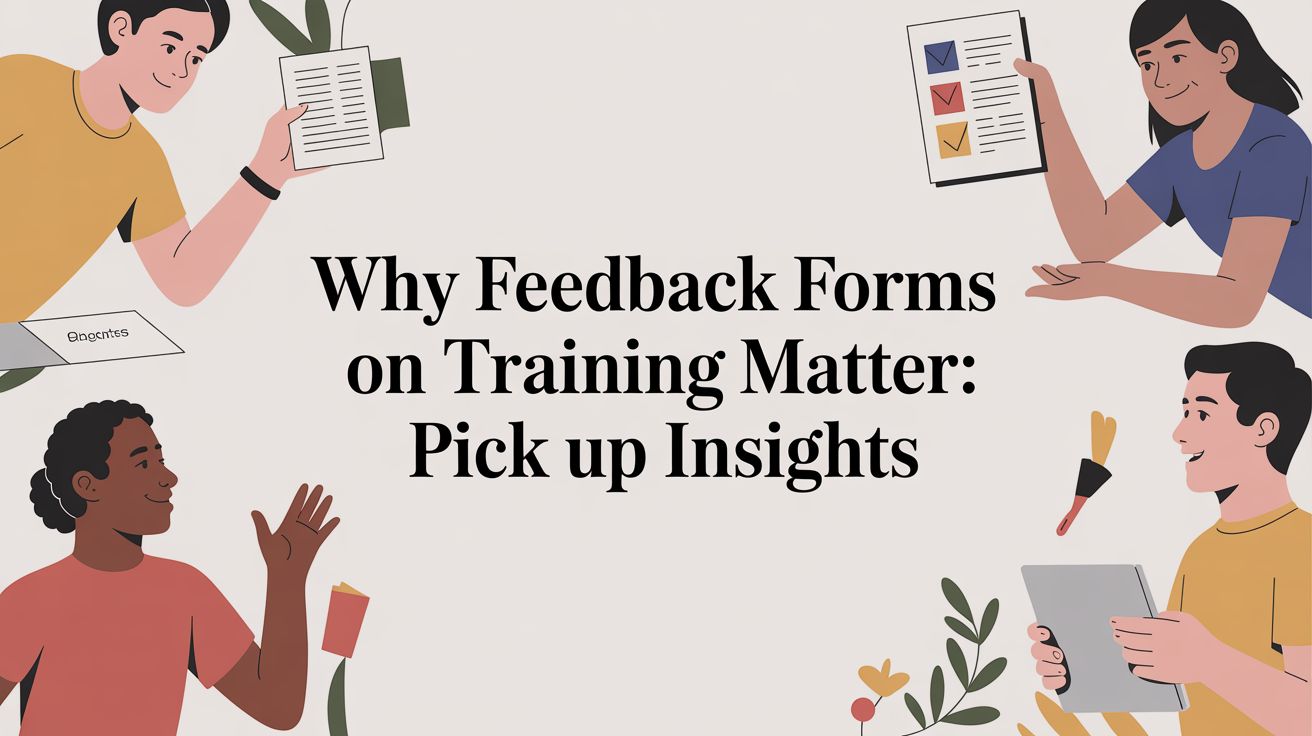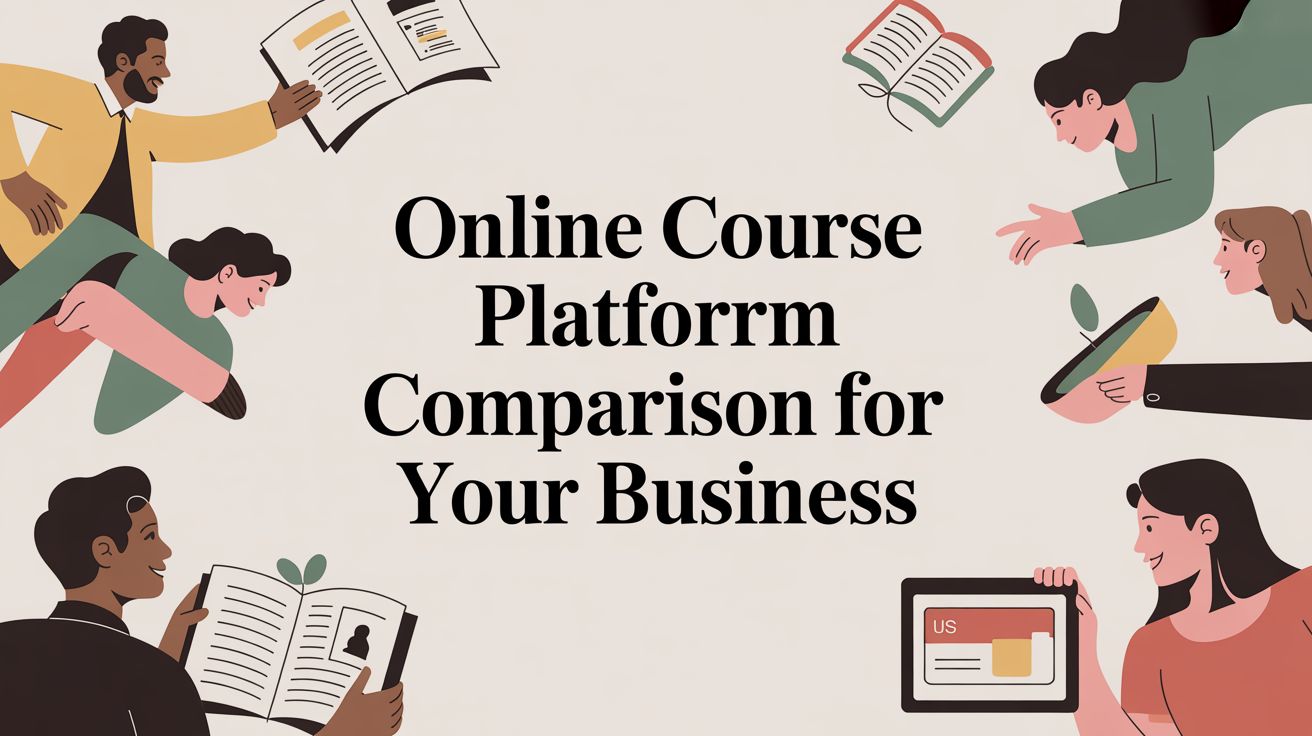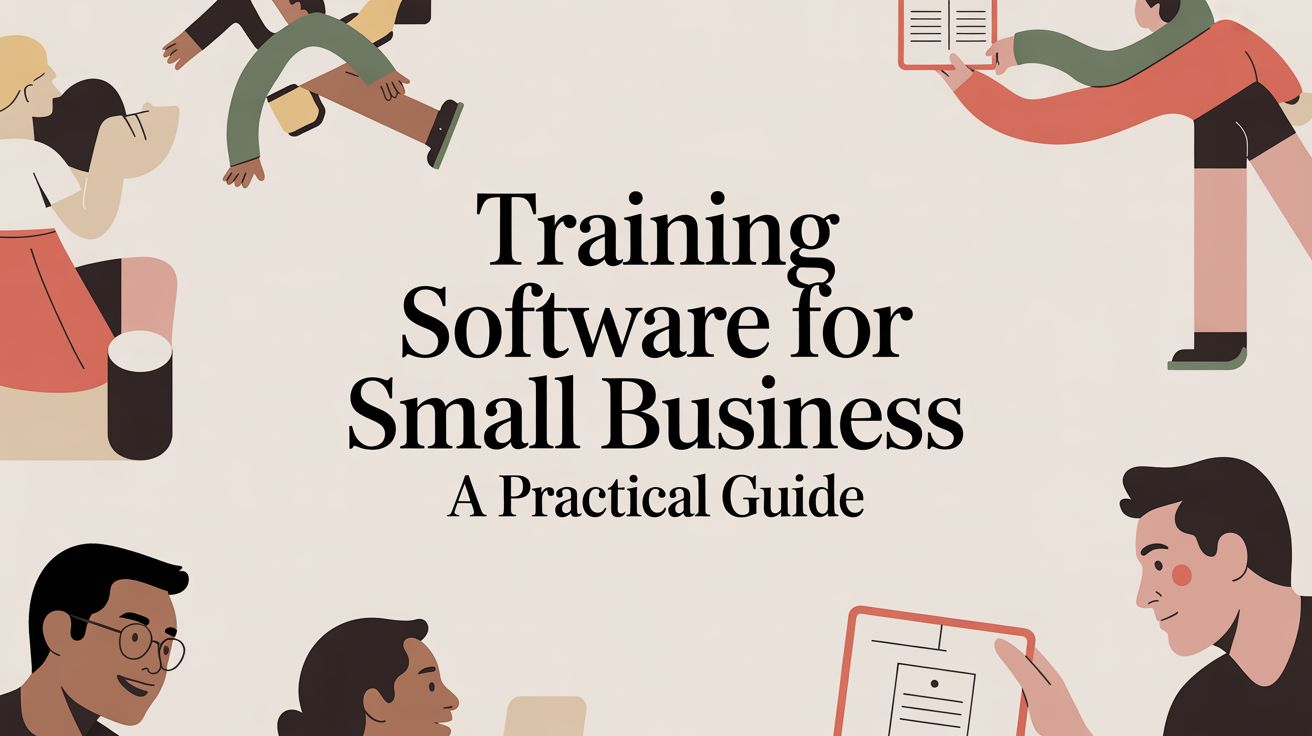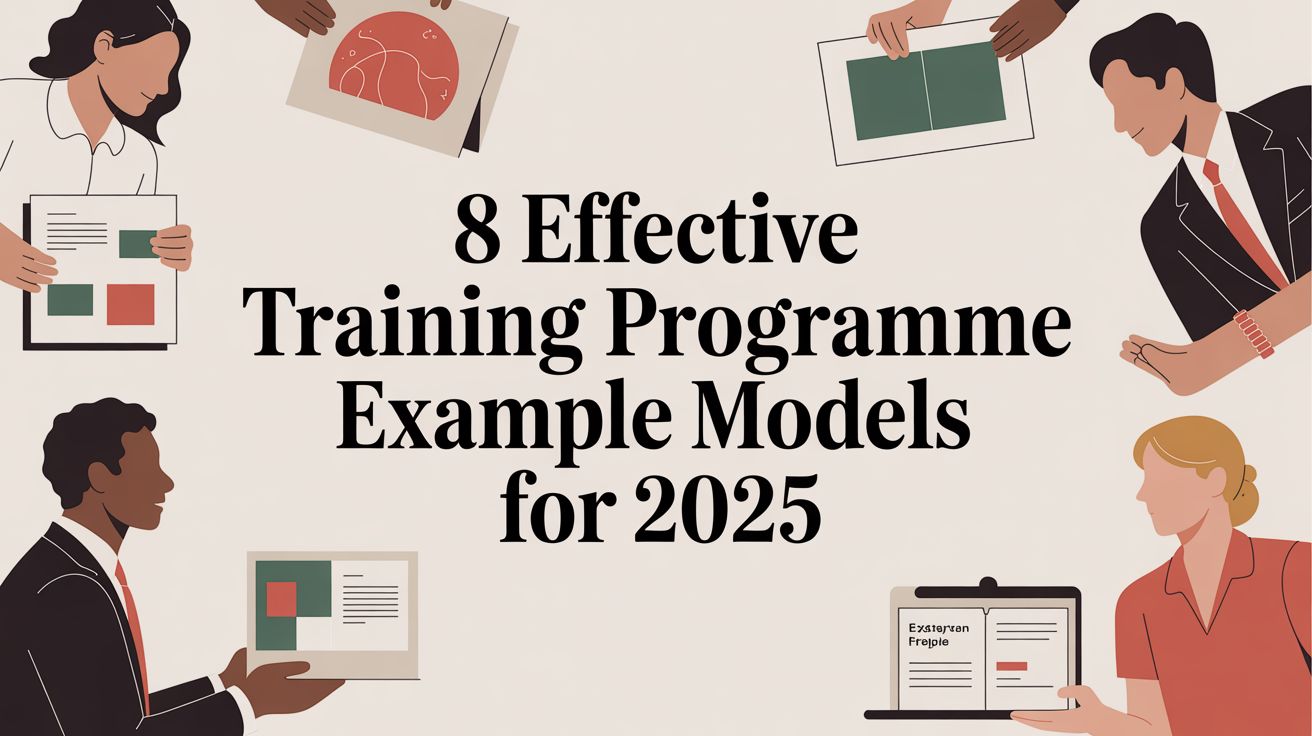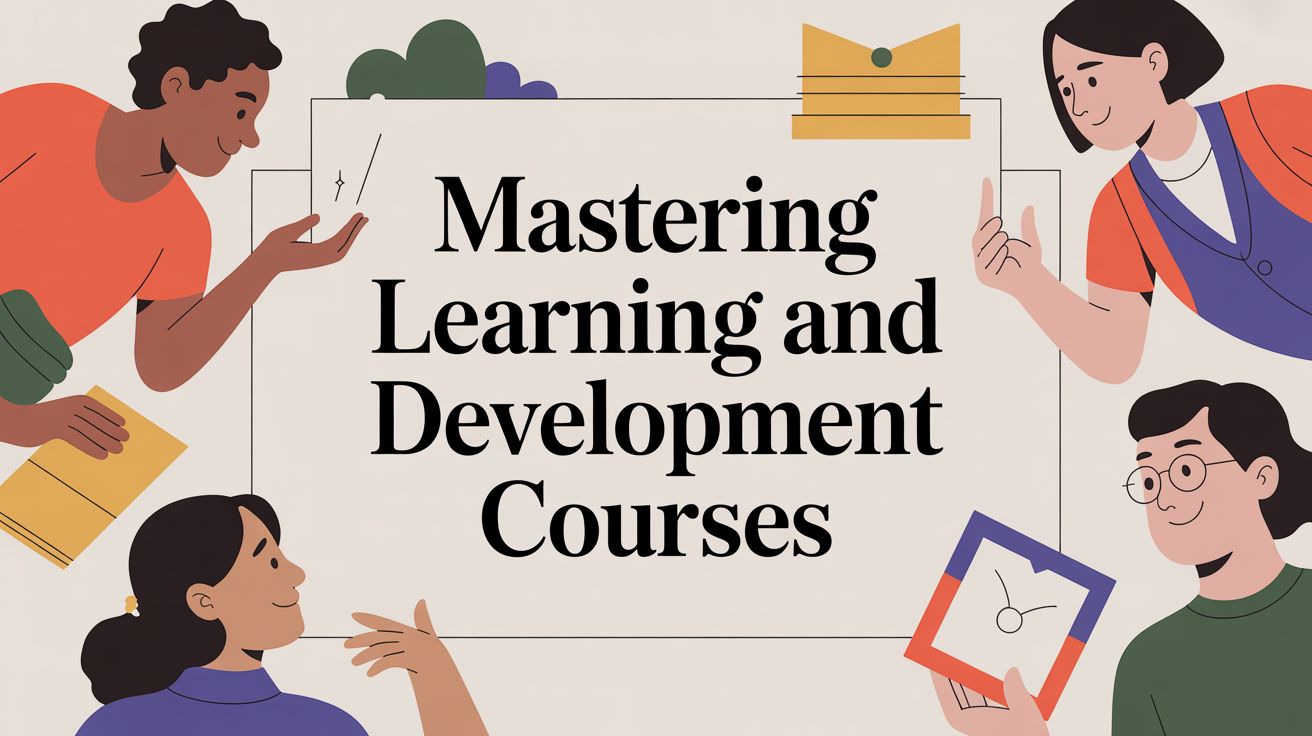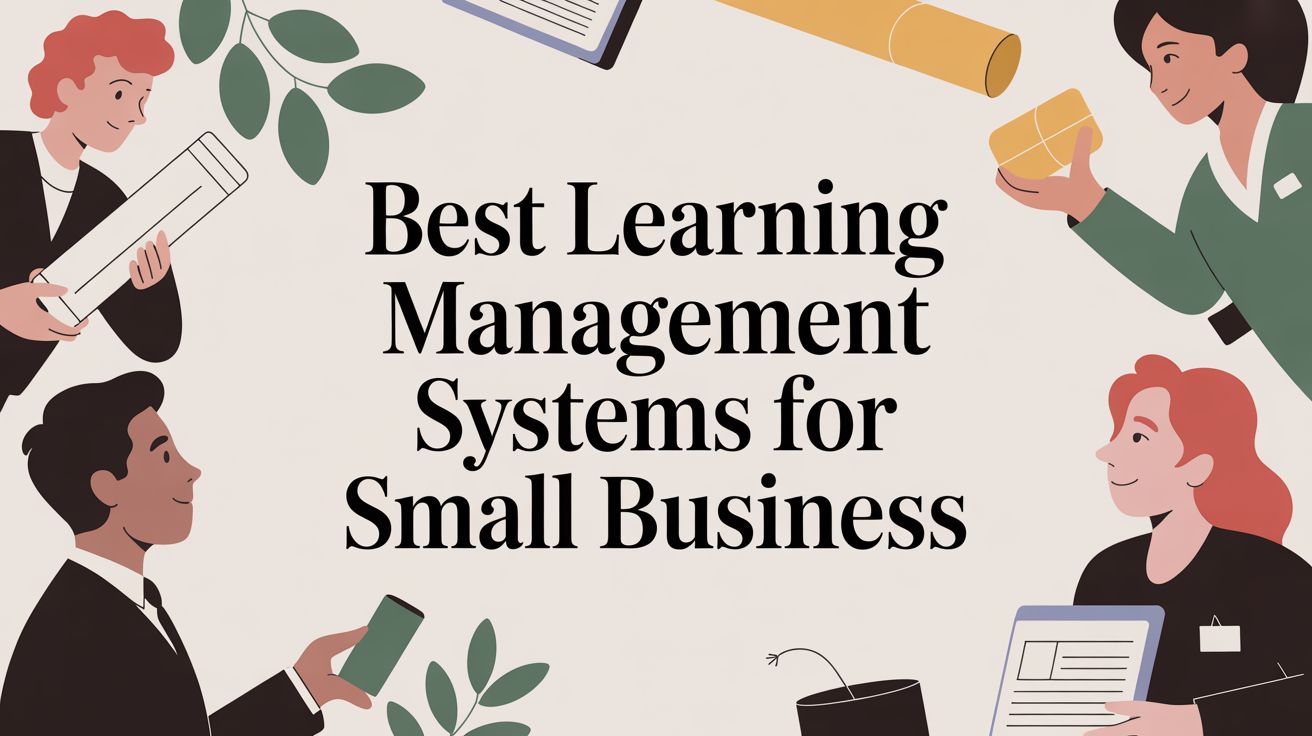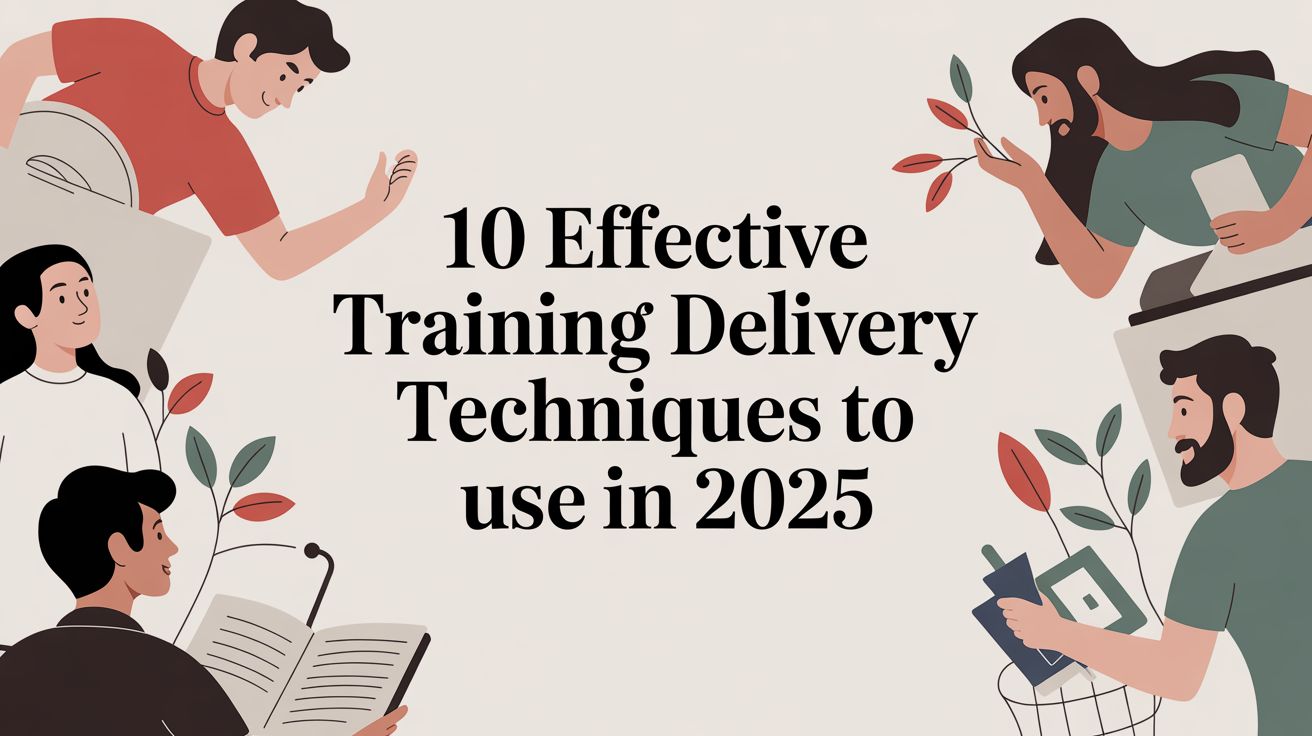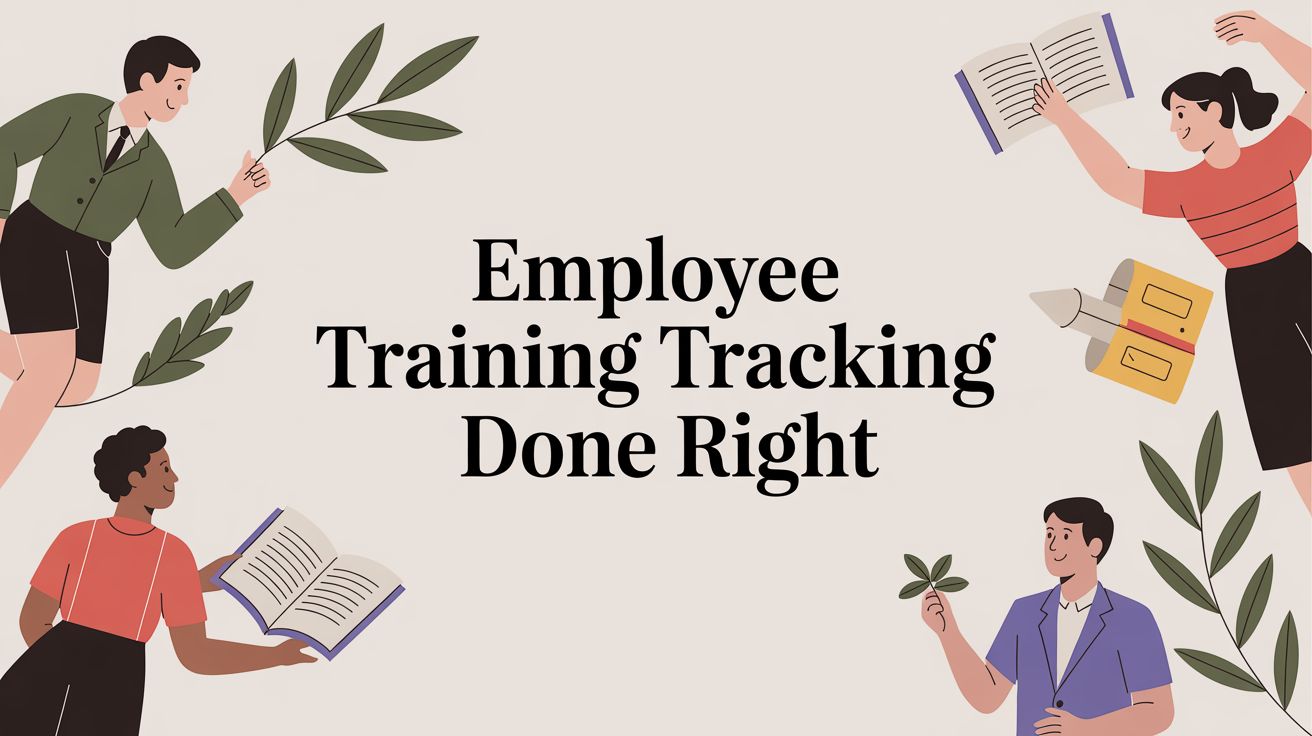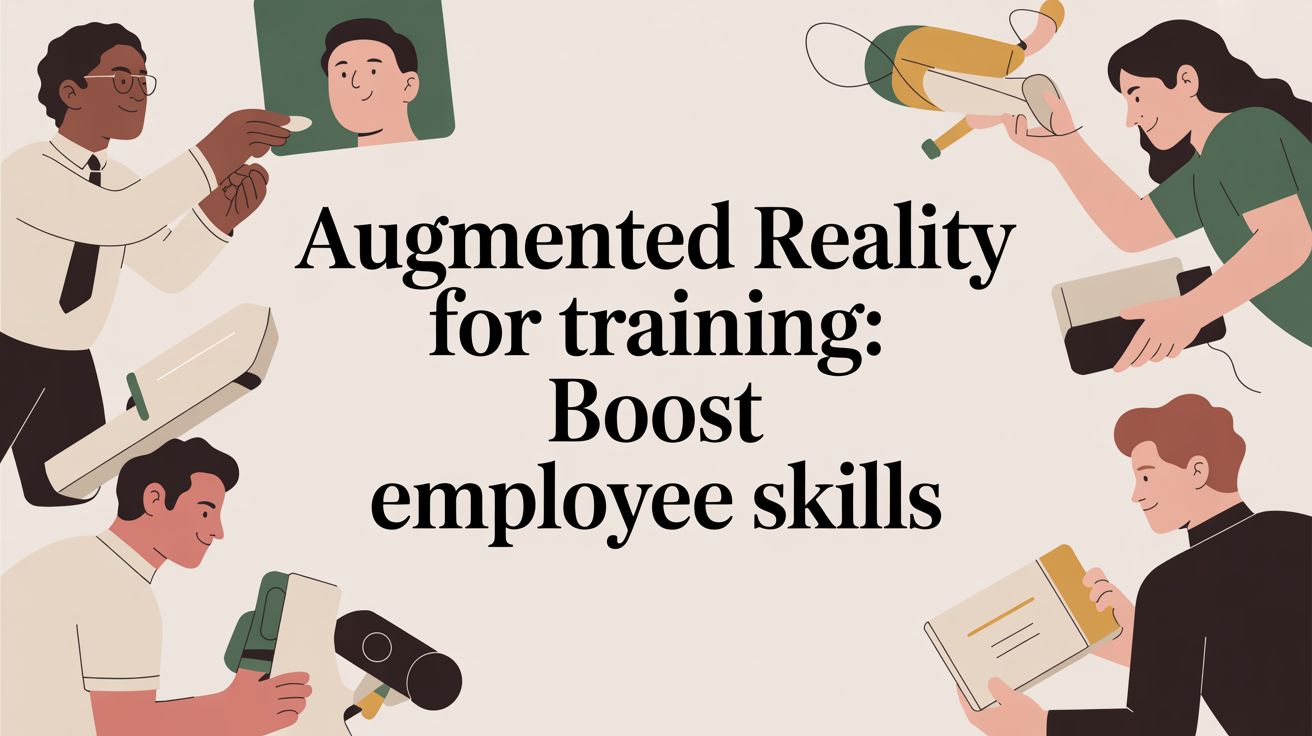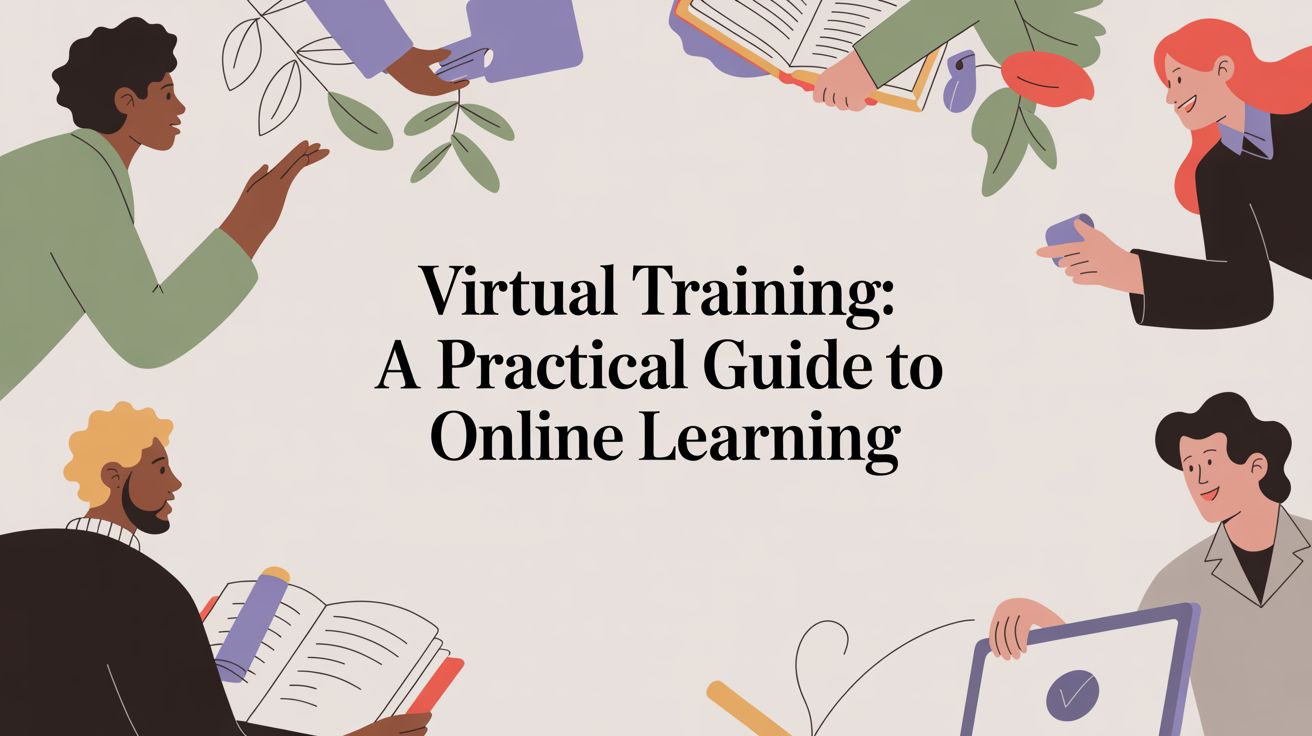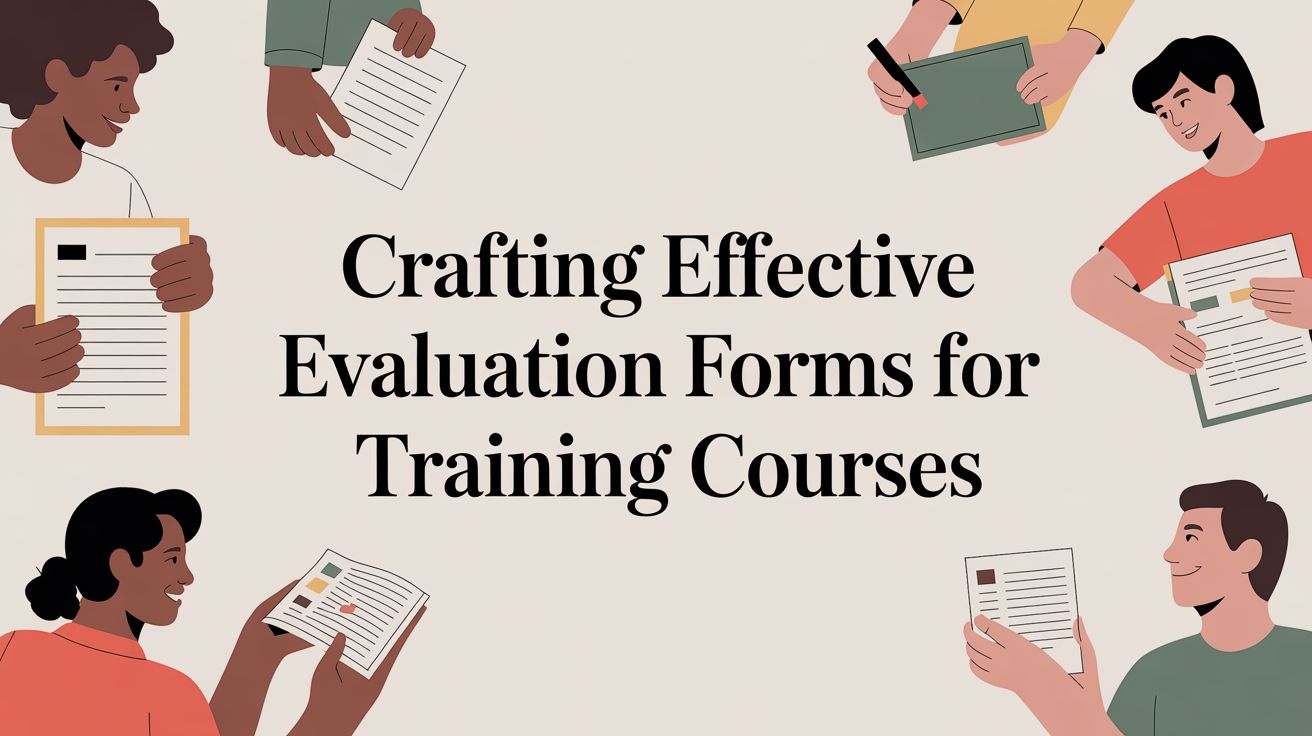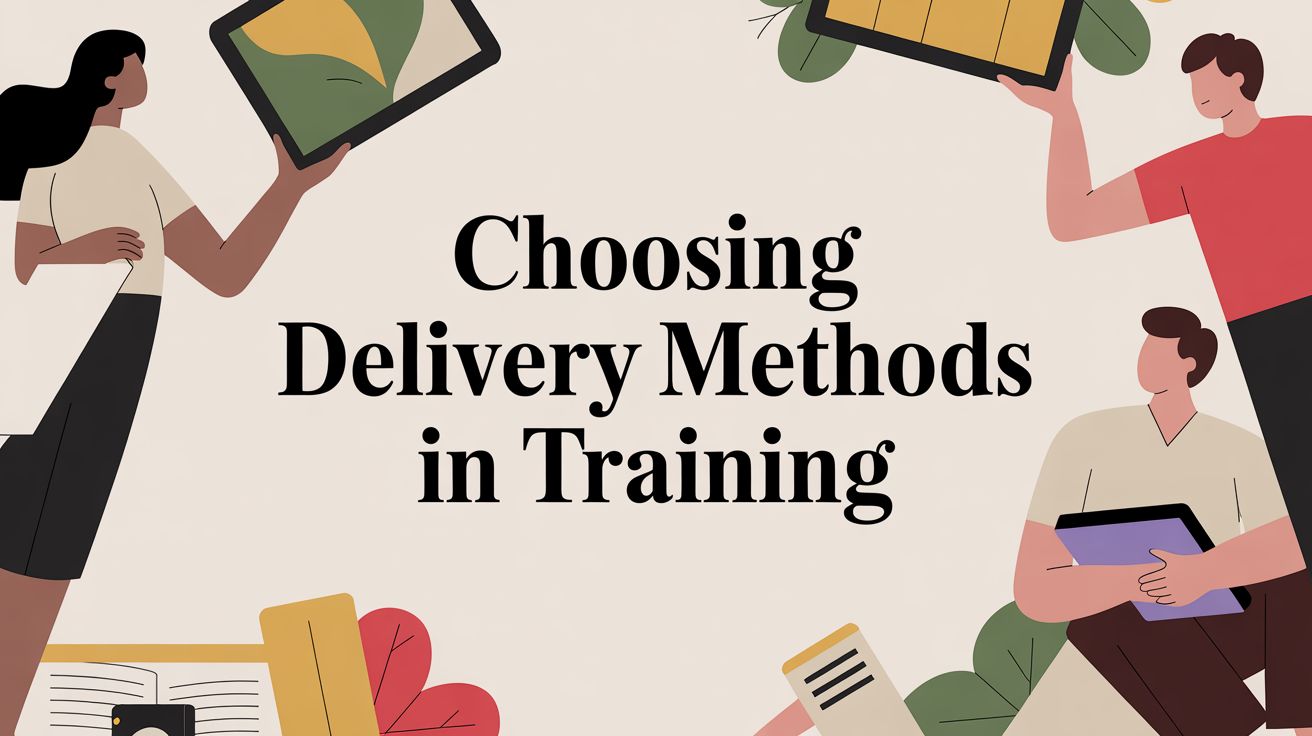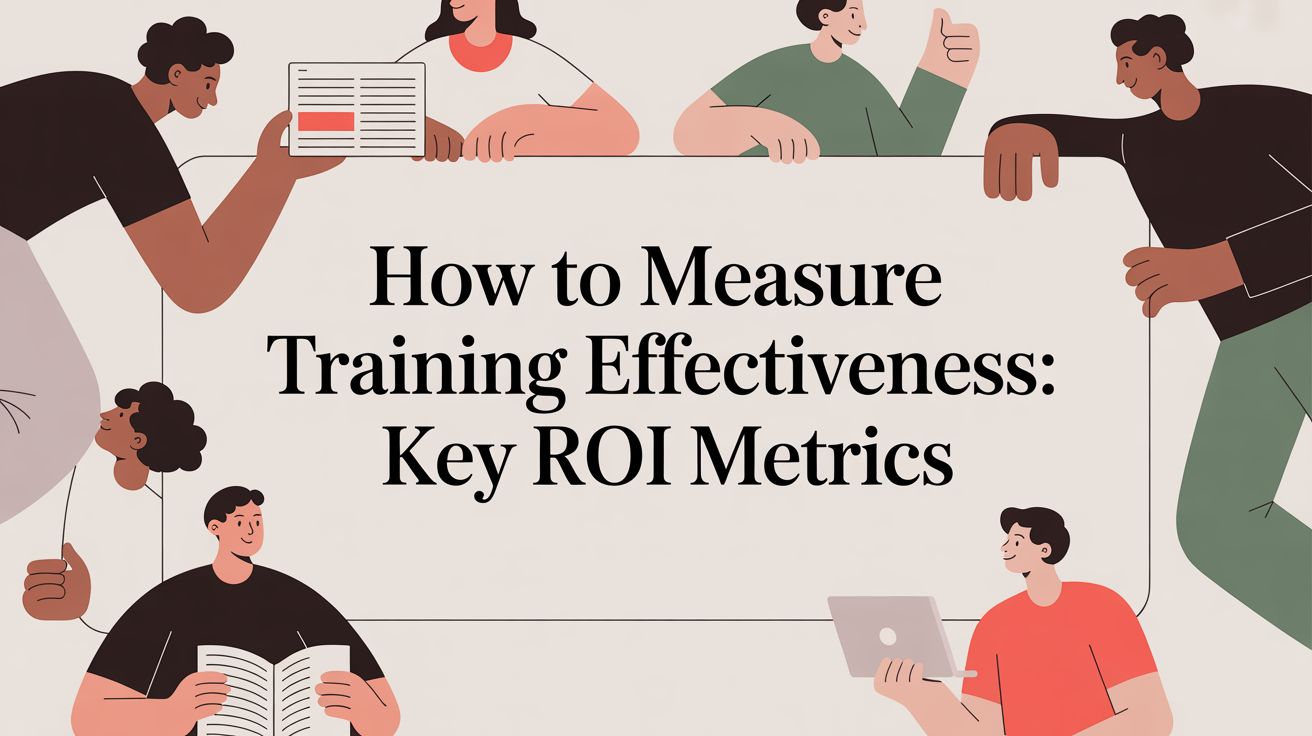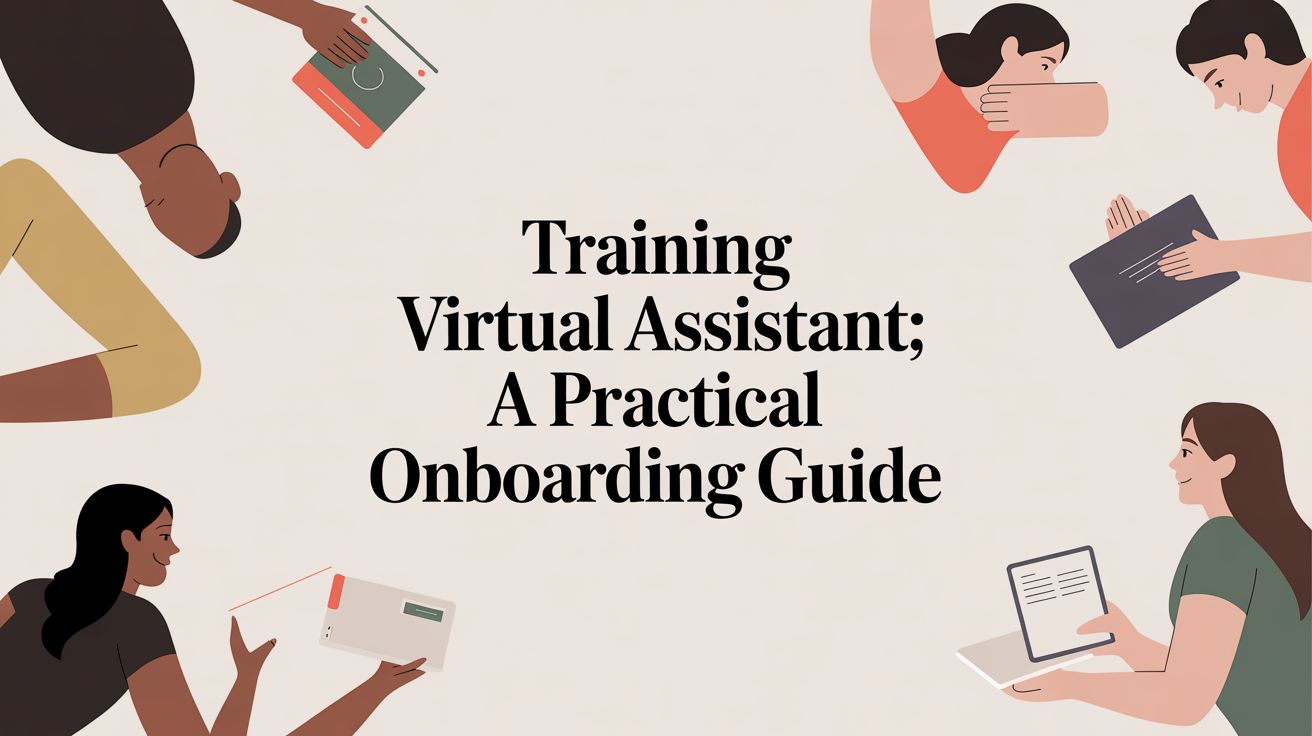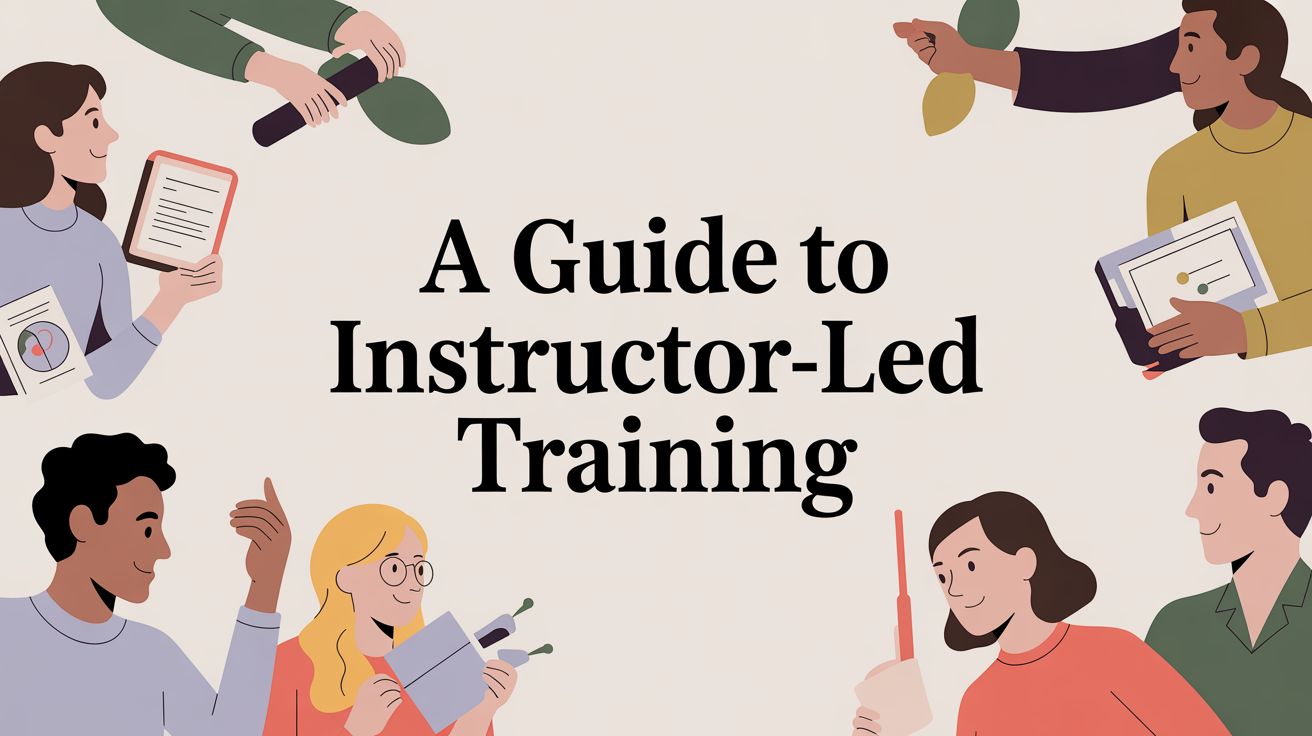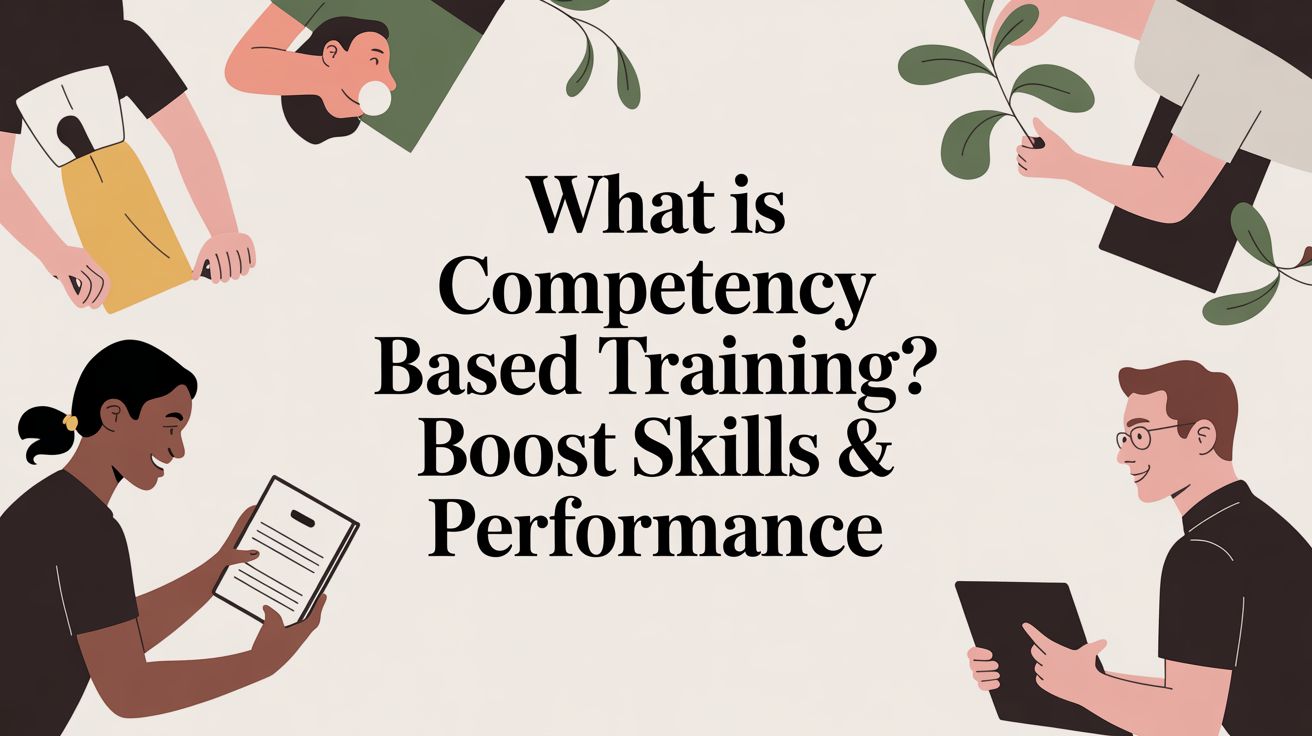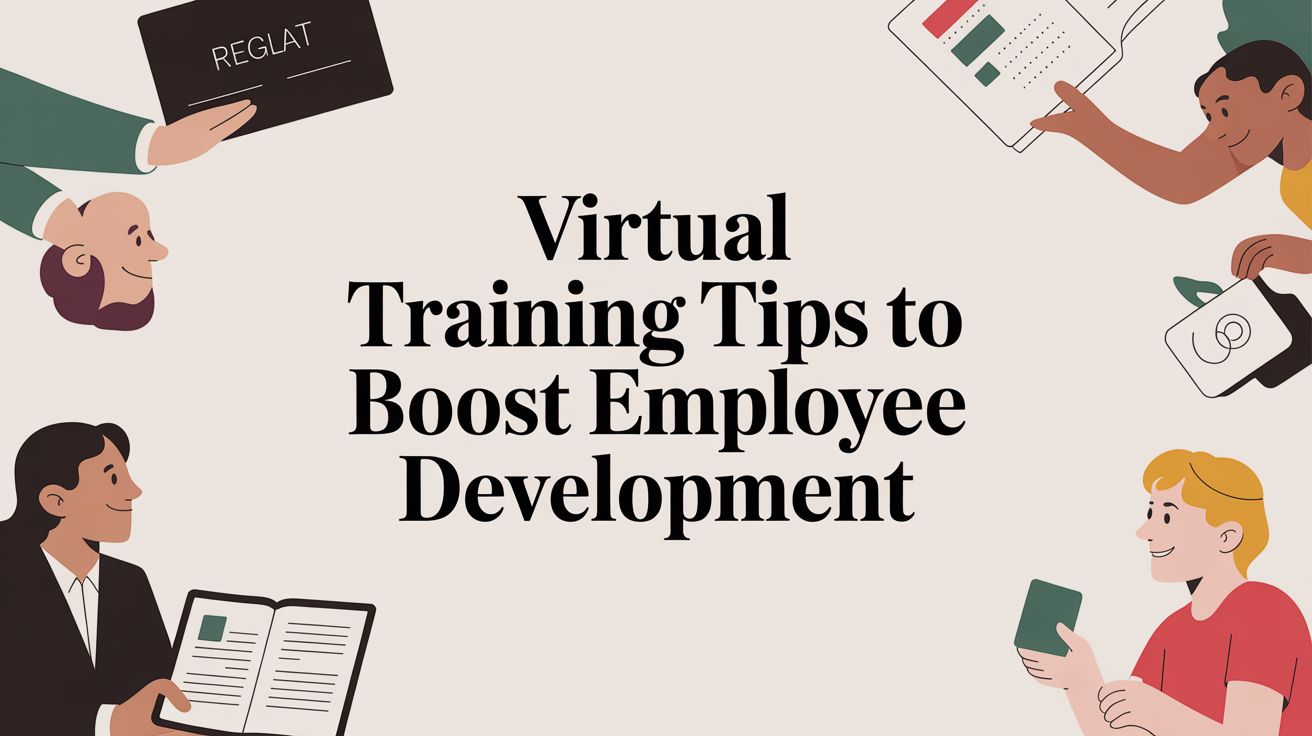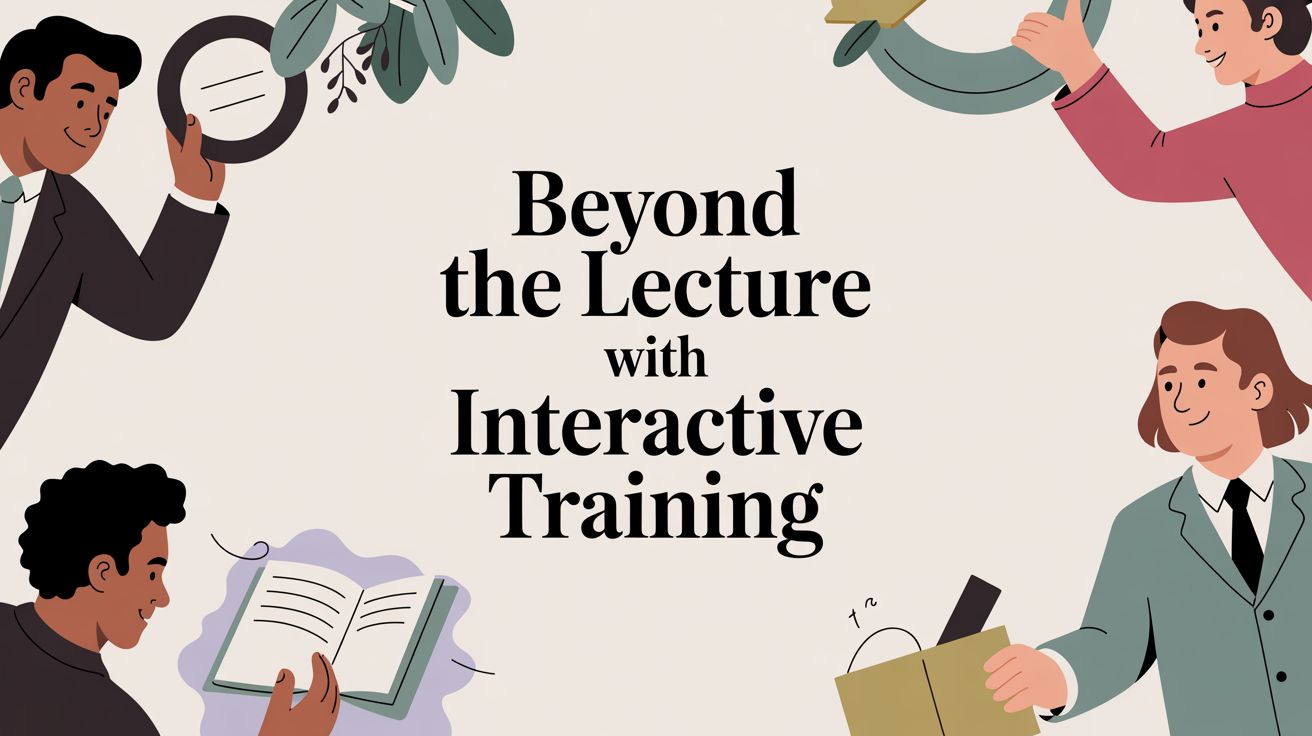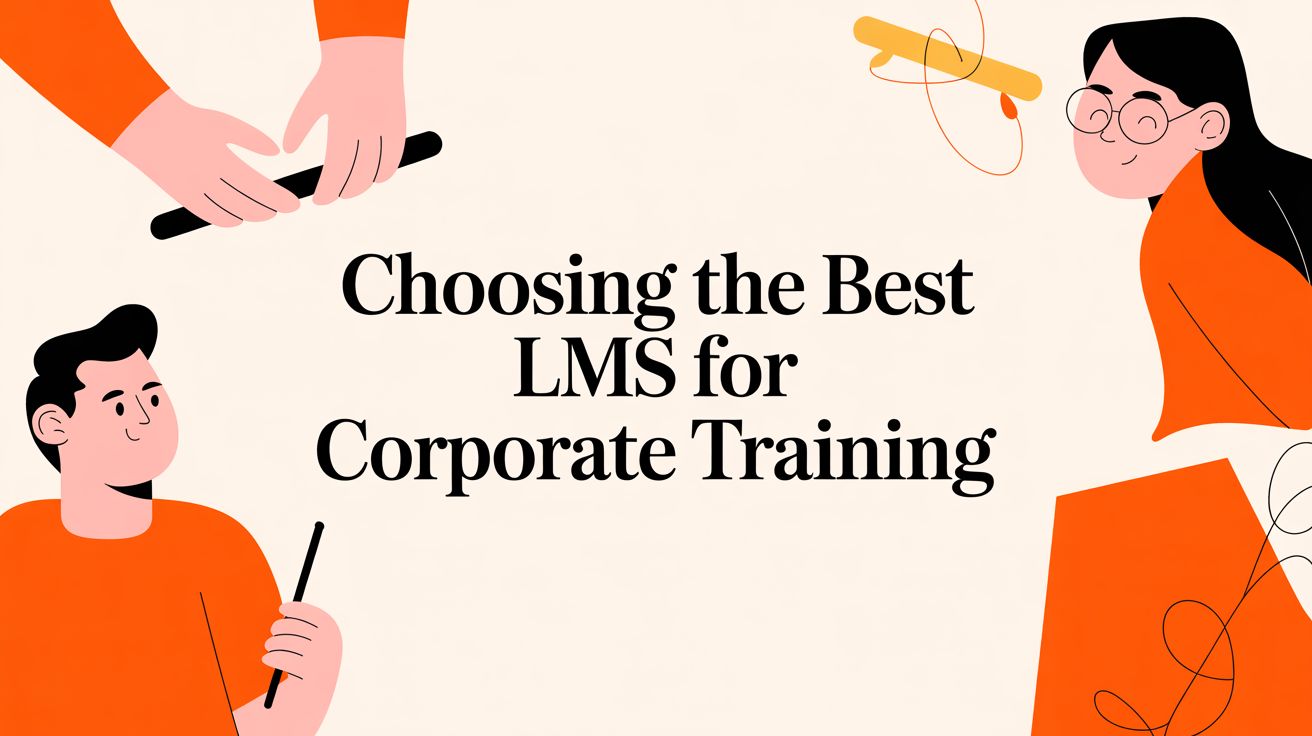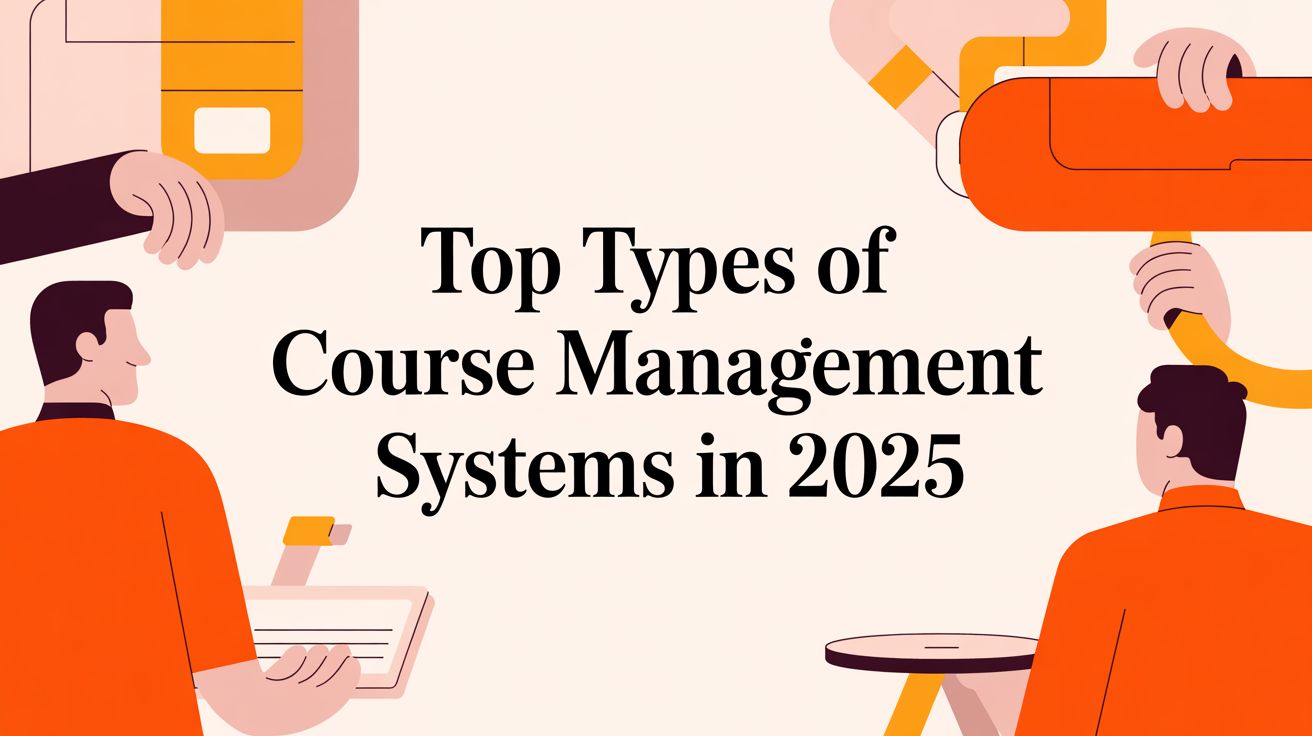How Competency-Based Training Drives Business Growth
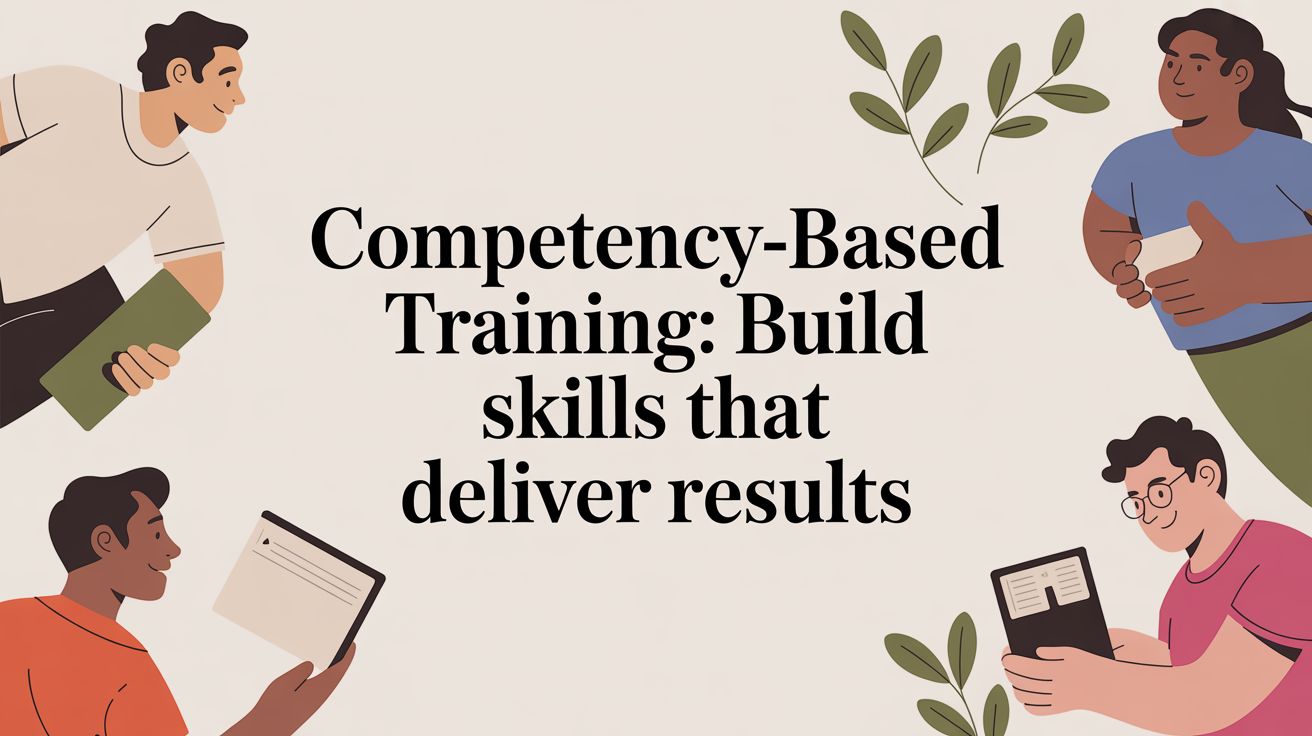
Let's be honest, traditional training often feels like a box-checking exercise. We measure success by how many hours an employee spent in a seat, not by what they can actually do when they get back to their desk.
Competency-based training flips that script entirely. Think of it less like a scheduled class and more like earning a pilot's license. You don't get to fly the plane just for showing up; you have to prove you can take off, navigate, and land safely. It’s all about demonstrating mastery.
This approach is about making sure every training dollar and every hour spent actually translates into real-world performance.
Why Competency-Based Training Matters Now
Skills have a shorter shelf life than ever before. To keep up, we need a workforce that isn't just trained but is genuinely proficient and can adapt on the fly. This is where the old model falls apart.
Traditional, time-based training treats everyone the same. The veteran sales rep and the brand-new hire sit through the same product training for the same eight hours. One is bored and disengaged, while the other might be struggling to keep up. The goal becomes finishing the course, not mastering the content. It’s a classic case of one-size-fits-none.
A Fundamental Shift in Focus
Competency-based training breaks away from the clock. Instead of tracking hours, it tracks the demonstrated mastery of specific skills. An employee only moves forward once they've proven they can apply what they've learned. Simple as that.
This creates a far more efficient, personalized, and effective learning culture.
- Pinpoint Accuracy: Training is laser-focused on closing the actual skill gaps an employee or team has, not just covering generic topics.
- Smarter Use of Time: Why make a seasoned expert sit through a beginner's module? If they can prove their skills, they move on, saving everyone time and money.
- Real Accountability: Success isn't about an attendance sheet. It's defined by measurable performance improvements and tangible business outcomes.
- Clearer ROI: Every investment in training is directly tied to building capabilities that drive the company forward.
Comparing the Two Approaches
The philosophical difference is stark. One method is obsessed with time spent, while the other is obsessed with skills gained. The table below really highlights the contrast.
Traditional vs Competency-Based Training at a Glance
| Aspect | Traditional Training | Competency-Based Training |
|---|---|---|
| Primary Goal | Course completion | Skill mastery and application |
| Pacing | Fixed schedule (same for all) | Flexible, learner-driven |
| Focus | Time spent in training | Demonstrated capabilities |
| Assessment | Often a final exam or quiz | Ongoing, performance-based tasks |
| Learner Path | Linear and uniform | Personalized and adaptive |
| Success Metric | Attendance and completion rates | Measurable on-the-job improvement |
Ultimately, it comes down to what you value more: a certificate of completion or a team that can consistently deliver results. The choice is pretty clear.
The bottom line is simple: Competency-based training prioritizes what a person can do over what course a person has attended. This ensures your training budget builds a genuinely capable workforce.
Of course, managing this kind of personalized, often instructor-led, approach requires the right tools. A dedicated training management system is built to handle the logistics of live sessions, unlike a standard Learning Management System (LMS) designed for e-learning. If you're weighing your options, our guide on choosing the best LMS for corporate training is a great place to start, as it helps clarify these differences.
What Makes Competency-Based Training Work
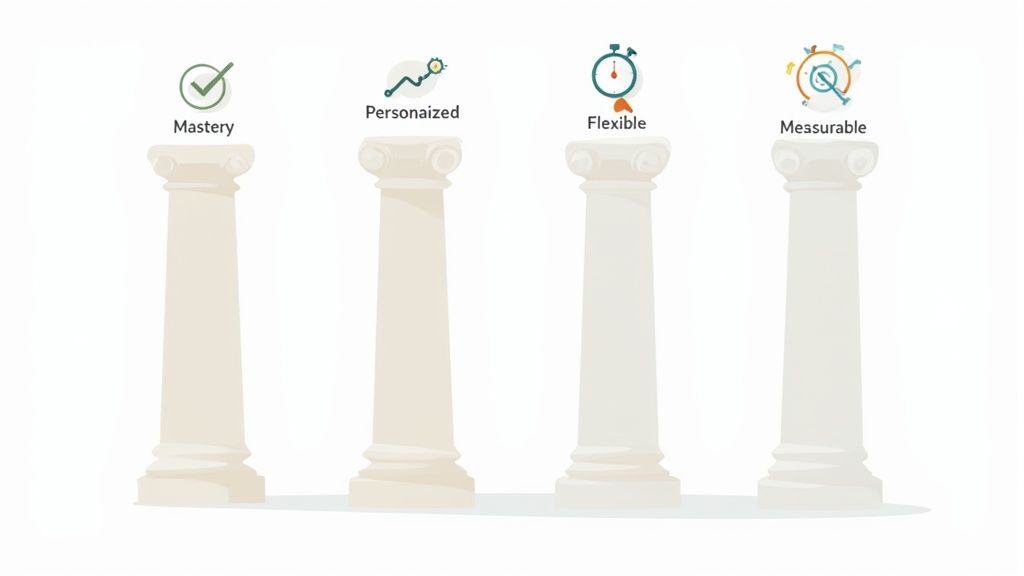
The real power behind competency-based training isn't some secret sauce; it’s in the architecture. Unlike old-school training where everyone marches along the same path at the same pace, this approach flips the script. It's built on a few core ideas that completely reframe what it means to learn on the job.
At its heart, this is about making sure learning is meaningful, measurable, and actually useful in an employee's day-to-day role. Let's pull back the curtain on the pillars that make it so effective.
Mastery-Based Progression
The biggest shift is moving away from the clock. Instead of time-in-seat, progress is based on proven skill. An employee only moves to the next topic after they’ve actually demonstrated they can apply the current one.
Think about a new salesperson. Rather than just sitting through a four-hour workshop on presentation skills, they have to run a mock client pitch and successfully navigate objections. They don't move forward until they nail it, ensuring they’re truly prepared for the real world.
This simple principle gets rid of the "seat time" fallacy, where just showing up is mistaken for understanding. It guarantees every step forward is built on a solid foundation of proven ability.
Personalized Learning Paths
Competency-based training starts with a simple truth: no two employees are the same. A senior engineer and a recent graduate have wildly different learning needs, even when tackling the same new programming language.
This model is designed to create custom-fit learning paths that zero in on specific, individual skill gaps.
- Smart Starting Point: Programs often kick off with a pre-assessment to see what an employee already knows and where they need to focus their energy.
- No More Redundancy: Learners can skip modules covering skills they’ve already mastered. This respects their time and keeps them engaged.
- Flexible Formats: People learn differently. Personalized paths can offer a mix of live sessions, hands-on exercises, and one-on-one coaching. Our guide on creating interactive training dives deeper into techniques that make this possible.
The efficiency gains here are huge. By focusing only on what’s needed, organizations can slash training time by up to 50% while boosting retention. It’s about getting people skilled up and back to being productive, faster.
Flexible Pacing for Deeper Learning
Because progress is tied to mastery and not a calendar, learners can move at their own speed. If someone gets a concept right away, they can move on. If they need more practice, they can take the time they need without falling behind.
This flexibility is a game-changer for adult learners who are juggling training with their actual jobs. It removes the pressure of a fixed schedule and fosters an environment where genuine understanding is the only thing that matters.
For instance, a support agent might master a new ticketing system in an afternoon, but a complex de-escalation technique could take a week of practice. The system handles both scenarios beautifully.
Clear and Measurable Learning Outcomes
Every piece of a competency-based program is tied to clear, measurable outcomes. Before anyone even starts learning, the organization decides exactly what a person must be able to do to be considered competent.
These aren't fuzzy goals like "understand the product." They are concrete, observable actions.
- "Demonstrate the top three product features to a prospective client."
- "Resolve a Tier 2 support ticket within the 30-minute SLA."
- "Lead a project kickoff meeting using the company's five-step framework."
This level of clarity gives everyone a precise roadmap. It makes assessments objective and ensures every training activity is directly tied to what people need to do on the job.
How Competency-Based Training Drives Business Growth
For any business looking to stay sharp, training can't just be a box-ticking exercise. It has to deliver a real, measurable impact on the bottom line.
This is where competency-based training really shines. Instead of just tracking attendance or hours spent in a classroom, it shifts the entire focus to what employees can actually do. It directly connects learning to specific business goals, ensuring every training dollar works harder.
Closing Skill Gaps to Stay Agile
Today’s market doesn't wait around. New technologies and roles pop up constantly, and your workforce needs to adapt—fast.
Companies that get ahead are the ones that equip their teams with the right skills at the right time. Competency-based training makes this possible by being incredibly targeted.
- It pinpoints the exact skill gaps holding your team back, so training time is spent on what truly matters.
- It allows for rapid reskilling when priorities shift, keeping projects on track without major downtime.
- It builds a flexible talent pool, creating a team of problem-solvers ready for any challenge.
This focus on agility is the foundation for a strong ROI. One retail chain, for example, cut its training time by 40% while simultaneously boosting customer satisfaction scores. Their training budget stopped being a simple expense and became a direct investment in operational excellence.
The need for this is more urgent than ever. The World Economic Forum's Future of Jobs Report 2025 found that employers expect 39% of a worker's core skills will change by 2030. The same report highlights that 77% of employers see increased productivity and 70% note improved competitiveness from effective training. You can dive into the full analysis on the World Economic Forum website.
When you link competencies directly to your strategic goals, training stops being a cost center and starts acting as a growth engine.
Maximizing Your Training ROI
How do you prove training is working? With competency-based programs, the answer is in the data. You can finally calculate a clear return on investment using concrete performance metrics.
Instead of vague feedback, you get hard numbers. Things like task completion rates and the time it takes for an employee to become fully competent give leaders solid evidence of what’s working.
Organizations often track a few key indicators to guide their budgets and planning:
- Time to proficiency for every key role.
- Percentage improvements in task performance after training.
- Cost savings from getting it right the first time and reducing retraining needs.
When you can tie these metrics back to business outcomes, training rightfully earns its seat at the strategic table.
Enhancing Retention and Internal Mobility
When you invest in your employees' skills, they notice. A focus on mastery and clear, personalized development paths doesn't just build competence—it builds loyalty.
This translates directly into lower turnover and a much stronger internal talent pipeline. Why? Because employees can see a future for themselves right where they are.
- It lights up a clear career path with defined skill benchmarks.
- It makes internal mobility a reality by mapping existing skills to open roles.
- It cuts down on hiring costs by helping you promote from within, based on proven capabilities.
Of course, managing live training schedules, tracking skill progression, and juggling logistics for face-to-face sessions can get complicated. This is where a dedicated training management system like Coursebricks becomes essential for keeping everything running smoothly.
Building a Culture of Continuous Learning
Great training isn't a one-and-done event. A competency-based approach naturally encourages ongoing skill development that becomes part of the company culture.
Teams get real-time feedback and can see their learning paths evolve as the business needs change. This creates a powerful culture of continuous improvement that drives innovation and makes the entire organization more resilient.
| Benefit | Impact |
|---|---|
| Faster Onboarding | New hires get up to speed up to 30% faster. |
| Skill Refresh | Keeps the entire team’s competencies sharp and current. |
| Cross-Training | Boosts team flexibility and collaboration. |
Organizations that embed this model are simply faster on their feet. They can adapt to market shifts without missing a beat because their people are always learning, always growing, and always ready.
Leveraging Data for Strategic Decisions
Competency data is a goldmine of insights. It can reveal hidden talent, highlight critical gaps before they become problems, and inform your entire talent strategy.
With the right analytics, training managers can proactively align programs with upcoming projects and strategic goals.
- Identify high-potential employees ready for leadership tracks.
- Spot team-wide skill gaps before they impact a project's success.
- Forecast future training needs based on the company’s roadmap.
Ultimately, competency-based training is more than just a better way to learn—it’s a catalyst for business growth.
By tightly linking skills to strategy, companies unlock a new level of agility and performance. Coursebricks provides the operational backbone to manage and scale these initiatives, giving you a single platform for scheduling, tracking, and reporting on live instructor-led training.
Ready to see how Coursebricks can power your competency-based strategy? Explore our platform and start optimizing your team’s skills today.
Your Blueprint for Implementing Competency-Based Training
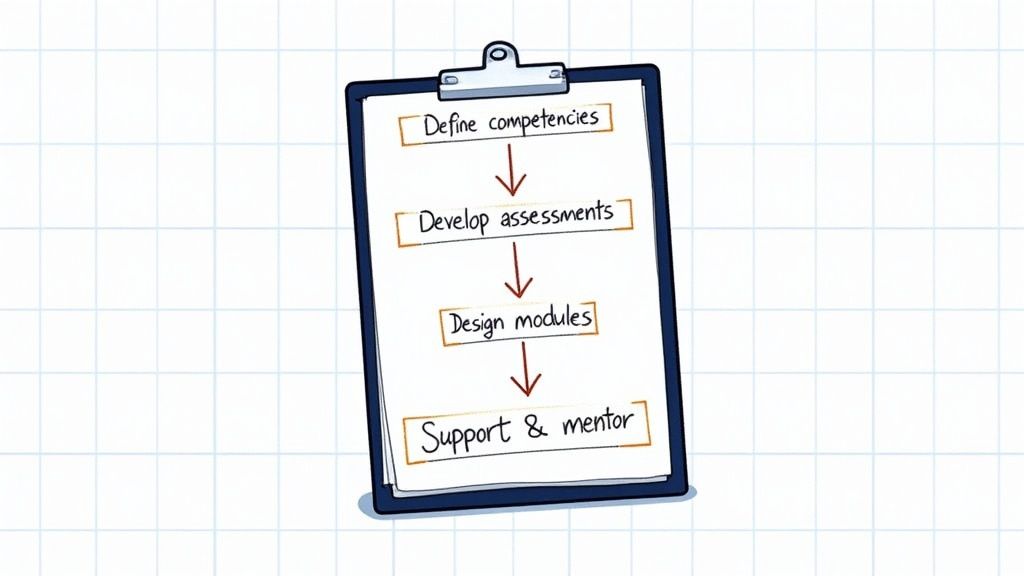
Shifting to competency-based training isn't something you do overnight. It’s a deliberate, thoughtful process that requires a solid plan to redefine how your organization builds skills. Think of it like drafting a blueprint for a high-performance engine—every part has to be carefully chosen and placed to get the best possible result.
This framework breaks the whole process down into clear, manageable stages. By following these steps, you can build a powerful program that directly connects learning to real-world job performance and your bigger business goals.
Step 1: Define Core Competencies
The entire program stands on one foundation: a deep understanding of what skills actually matter. You can't train for mastery if you haven't clearly defined what "good" looks like for every role. This first step is all about pinning down the critical knowledge, skills, and behaviors that drive success.
This goes way beyond just listing job duties. It takes a multi-pronged approach to find out what really makes someone great at their job.
- Job Analysis: Don't just read the job description. Watch your top performers in action. What do they do differently? What skills do they pull out when things get tough?
- Stakeholder Interviews: Sit down with department heads, team leads, and veteran employees. Ask them what separates an average employee from a rockstar.
- Future-Focus: Don’t just build for today. Look ahead three to five years. What are your company's goals, and what new skills will your team need to hit them?
The result of this stage should be a clear competency framework. This is your map—a documented guide to the essential skills for key roles that will steer all your training and assessment decisions.
Step 2: Develop Robust Assessment Tools
Once you know which competencies you're targeting, you have to figure out how to measure them. In competency-based training, assessments aren't about a final grade; they're the gatekeepers to progression. They have to be authentic, reliable, and tied directly to the work people do every day.
The goal is to create ways to prove an employee can apply a skill, not just remember a piece of information.
Key Tip: The mindset needs to shift from "What does the learner know?" to "What can the learner do with what they know?" This is the core principle for designing assessments that truly reflect capability.
Effective assessment tools come in many forms:
- Performance-Based Tasks: Have a customer service rep handle a simulated call from an angry customer.
- Project-Based Evaluations: Ask a project manager to create a complete project plan for a sample initiative.
- Direct Observation: Let a senior mechanic watch a junior tech perform a critical repair.
- Peer Reviews: Use 360-degree feedback to get a well-rounded view of soft skills like collaboration.
Step 3: Design Flexible Learning Modules
With your competencies mapped and your assessments ready, it's time to build the learning content. The magic words here are modularity and flexibility. Instead of creating one-size-fits-all courses, you’ll design shorter, focused modules that each target a specific skill.
This approach lets you create personalized learning paths. If an employee is already a pro in one area, they can skip that module and focus on where they actually need to grow. This respects their time and gets them up to speed faster. This is especially important for live sessions, and our guide on https://coursebricks.io/blog/instructor-led-training has great strategies for making them more targeted.
Using specialized competency and skills management software can be a huge help here, making it easier to track who needs what and how they’re progressing.
Step 4: Create a Supportive Learning Environment
A great program is more than just good content and smart assessments. You need to build a culture that actively supports continuous learning. That means giving people the resources, encouragement, and feedback they need to thrive.
Feedback is the fuel for a competency-based system. Learners need to know—regularly and constructively—where they stand and exactly what to do to get better. This is where the human element really shines.
A truly supportive environment includes:
- Regular Feedback Loops: Instructors and managers should offer consistent, actionable advice after every assessment.
- Mentorship and Coaching: Pair newer employees with seasoned veterans who can offer guidance and real-world perspective.
- Accessible Resources: Make sure learners can easily find supporting documents, connect with experts, and access practice environments.
Step 5: Manage the Logistics with a Training Management System
Let's be realistic. Juggling a dynamic, personalized training program is a massive logistical challenge, especially when live instruction is involved. Trying to manage schedules, track skill progress, assign instructors, and handle assessments for hundreds of people with spreadsheets is a recipe for disaster.
This is where a dedicated Training Management System (TMS) like Coursebricks becomes indispensable. Unlike a standard LMS built for self-paced e-learning, a TMS is designed to handle the operational side of live and hybrid training. It helps you manage schedules, track attendance, and report on skill acquisition across the entire company, making sure your program runs like a well-oiled machine.
How to Manage and Scale Your Training Programs
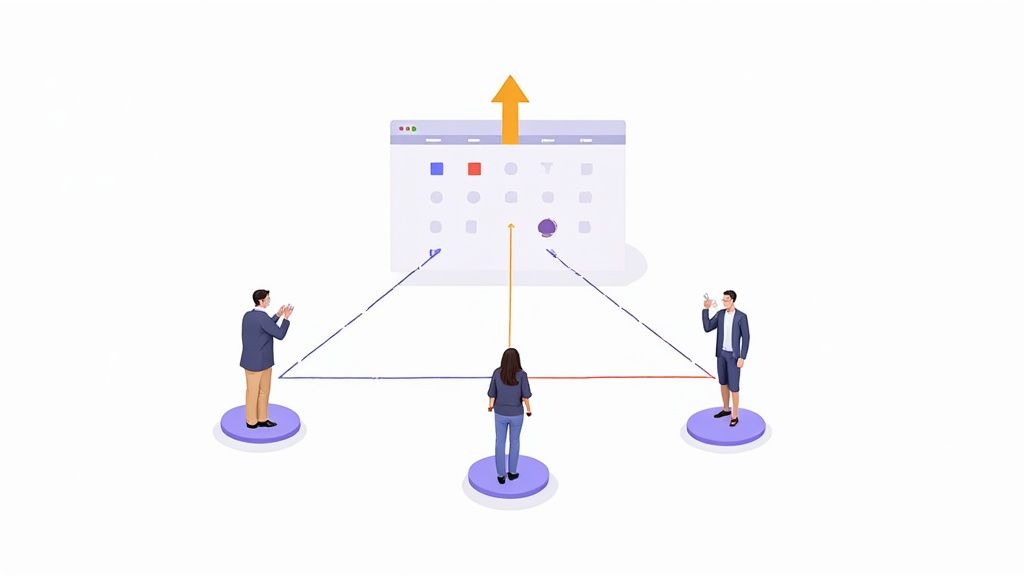
Getting a competency-based training program off the ground is a huge win, but the real work begins when you have to run it day-to-day and, eventually, scale it up. Because this model is so personalized and dynamic, it brings a whole new level of operational complexity that you just don't see with one-size-fits-all training.
Once your program is live, you're not just a designer anymore—you're an orchestra conductor. You’re juggling individual learner progress, instructor schedules, resource allocation, and constant evaluation. And as you bring on more people and add new roles, those moving parts multiply fast.
The Challenge of Scaling Live Instruction
Let’s be honest, the most impactful parts of competency-based training are often the live, hands-on components: instructor-led workshops, one-on-one coaching, and practical skill checks. They're fantastic for proving someone actually knows their stuff, but they can quickly turn into a logistical nightmare.
Trying to coordinate schedules for dozens of instructors and hundreds of learners—each on their own unique timeline—with spreadsheets and email is a recipe for disaster. It won’t take long before you’re buried in scheduling conflicts, missed sessions, and frustrated people on all sides. This is where a dedicated Training Management System (TMS) becomes non-negotiable.
A TMS is purpose-built to handle the tricky logistics of live, hybrid, and instructor-led training. While a standard LMS is great for self-paced eLearning, a TMS shines when it comes to managing the who, what, when, and where of live instruction.
Best Practices for Effective Program Management
To keep your program from buckling under its own weight as it grows, you need a solid operational game plan. The goal is to give every learner the support they need without drowning your administrative team in busywork.
Here are a few practices that make all the difference:
- Centralize All Scheduling: Put everything—from group classes to individual coaching sessions—in one place. This is the only way to avoid double-bookings and make the best use of your instructors' time.
- Automate Communications: Set up automated reminders, confirmations, and follow-ups. You'll see a huge drop in no-shows and spend far less time manually chasing people down.
- Track Competencies, Not Just Completions: Your system needs to go deeper than just checking a box for attendance. It has to track progress against specific skills to give you the data needed to truly validate mastery.
This push for provable skills is why the global competency-based education market is projected to swell from an estimated $50 billion in 2025 to nearly $90 billion by 2033. Organizations are clearly hungry for training that delivers tangible results.
Maintaining Quality and Consistency at Scale
As you scale, the single biggest risk is a dip in quality. You have to ensure that a "mastered" competency means the same thing whether the employee is in marketing or engineering. A huge part of this is knowing how to approach measuring training effectiveness, which validates that your standards are being met across the entire organization.
To keep your standards high as you grow, zero in on these key areas:
- Standardize Assessment Criteria: Create crystal-clear rubrics for every competency assessment. Just as importantly, train all your instructors and assessors on how to use them consistently.
- Monitor Instructor Utilization: Keep an eye on which instructors are in high demand and where you might have gaps. This lets you get ahead of resource crunches by hiring or cross-training people proactively.
- Gather Continuous Feedback: Make it a habit to collect feedback from both learners and instructors. This is the fastest way to spot bottlenecks, confusing content, or areas where people feel unsupported.
A robust TMS like Coursebricks is designed for exactly this. It becomes the command center for your entire training operation, pulling all your scheduling, registration, and reporting into one coherent view. This is especially critical for managing the tangled logistics of virtual training and hybrid models. By offloading the administrative heavy lifting, you free up your team to focus on what they do best: delivering incredible training that builds real-world skills.
Answering Your Questions About Competency-Based Training
When you start talking about moving to a skills-first culture, questions pop up. And that's a good thing. Shifting from the old "time-in-seat" model to one focused purely on outcomes is a big change, so it's natural to wonder how it all works on the ground.
Let's clear up some of the most common questions and misconceptions we hear from business leaders and training managers. Getting a handle on these details will help you sidestep potential roadblocks and build a program that really moves the needle.
Is This Just for Technical or Hands-On Skills?
This is probably the biggest myth out there. It’s easy to see how competency-based training fits a technical role where you can clearly see if someone can do the job—like a coder writing clean script or a mechanic fixing an engine. But the model is just as effective for those crucial, harder-to-pin-down soft skills.
The trick isn't the type of skill, but how you define and measure it. For soft skills, you just have to get more creative than a multiple-choice quiz.
- Leadership: Instead of a lecture on feedback, have a manager run a role-playing session where they have to deliver tough, constructive criticism.
- Communication: Don't just talk about presentation skills. Have a salesperson deliver a mock pitch to a panel acting as a potential client.
- Problem-Solving: Give an employee a real-world case study and ask them to break down the problem and present a workable solution.
By focusing on what people can do—the observable behaviors—you can build genuinely capable leaders, collaborators, and communicators.
How Is This Really Different from Our Current Training?
The core difference is the finish line. Most corporate training ends when the clock runs out. Competency-based training ends only when the learner can actually do the thing you're training them to do. It’s a simple but powerful shift from "Did you show up?" to "Can you perform?"
In a traditional training session, everyone moves at the same speed. The advanced people get bored and tune out, while those who need more time get left in the dust. It's inefficient by design.
In a competency-based model, progress is personal. It's all about mastering the skill, not logging hours. This simple change ensures every minute spent learning is a minute well spent.
Does Competency-Based Training Work in Our Industry?
Yes. The focus on mastering critical skills is universal. Whether you're in healthcare, manufacturing, tech, or retail, if your business depends on people who know how to do their jobs well, this model will work. The principles stay the same, even if the skills look different.
Think about it this way:
- A nurse demonstrates competency not by passing a test, but by correctly administering a medical procedure on a simulation dummy.
- A factory worker proves mastery by calibrating a complex piece of equipment safely and getting it right the first time.
- A call center agent shows their skill by successfully turning a conversation with a furious customer into a positive one.
The model is flexible enough to fit any environment where performance depends on specific, demonstrable abilities.
What Happens to Our Instructors in This Model?
Their role doesn't disappear—it gets more important, but it also changes completely. They shift from being the "sage on the stage" to the "guide on the side." Forget long, one-way lectures. Instructors become hands-on coaches and facilitators.
Their new job is far more impactful:
- Giving Personalized Feedback: They work one-on-one with learners, pinpointing exactly where they went wrong in an assessment and what to do next.
- Validating Skills: They are the experts who watch, evaluate, and ultimately sign off that a learner has truly mastered a skill.
- Mentoring and Coaching: They're the go-to resource for tough questions, offering targeted advice and helping learners push past roadblocks.
This makes any time with an instructor incredibly valuable, because it's focused entirely on targeted coaching and practice. Juggling all these moving parts—the personalized schedules, the live assessments, the feedback loops—is exactly what a training management system like Coursebricks is designed for. It lets you manage the complexity of real-world skill development without drowning in spreadsheets.
Ready to explore Coursebricks?
Manage training programs, automate emails, and generate detailed reports — all in one place.

